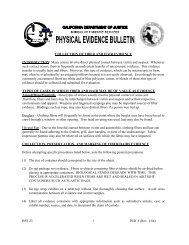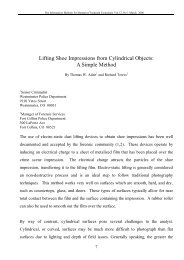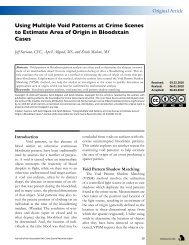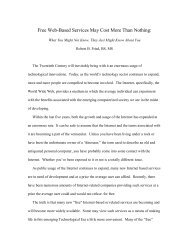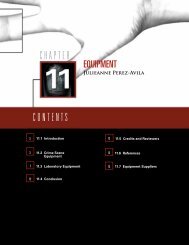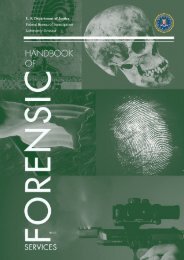Collection of physical evidence in sexual assault - Crime Scene ...
Collection of physical evidence in sexual assault - Crime Scene ...
Collection of physical evidence in sexual assault - Crime Scene ...
You also want an ePaper? Increase the reach of your titles
YUMPU automatically turns print PDFs into web optimized ePapers that Google loves.
Sta<strong>in</strong>s Found at <strong>Crime</strong> <strong>Scene</strong> (cont'd)<br />
B. Goals <strong>of</strong> Biological Evidence <strong>Collection</strong><br />
• Collect as much sample as possible from a s<strong>in</strong>gle source.<br />
• Keep biological <strong>evidence</strong> sta<strong>in</strong> concentrated.<br />
• Insure that the sample is not <strong>in</strong>advertently mixed with other biological samples (e.g. contam<strong>in</strong>ated)<br />
• Change gloves if they become sta<strong>in</strong>ed with any biological sample.<br />
• Do not talk over any biological <strong>evidence</strong> sample.<br />
• Handle the sample <strong>in</strong> a manner, which m<strong>in</strong>imizes deterioration <strong>of</strong> the sample.<br />
• Air-dry (<strong>in</strong> a stream <strong>of</strong> cool air) the sample as fast as possible.<br />
C. Recommendations for collect<strong>in</strong>g biological <strong>evidence</strong> sta<strong>in</strong>s:<br />
• Handle the <strong>evidence</strong> sta<strong>in</strong>s as little as possible. When possible, submit the item with the sta<strong>in</strong>. This<br />
is the easiest and best method to collect biological <strong>evidence</strong>. If the sta<strong>in</strong> is on a smooth, non-porous<br />
surface and can be easily dislodged, protect if from contact with other objects (e.g. immobilize <strong>in</strong><br />
box).<br />
• If the sta<strong>in</strong> is on a large object with a porous surface (wood or carpet), the area with the sta<strong>in</strong> can be<br />
cut out and packaged <strong>in</strong> paper. Be sure to <strong>in</strong>clude a portion <strong>of</strong> the unsta<strong>in</strong>ed material as a control.<br />
• If it is not possible to collect the object or cut out the sta<strong>in</strong>, the sta<strong>in</strong> may be collected by us<strong>in</strong>g a<br />
slightly moistened (with distilled water) cotton swab. While collect<strong>in</strong>g the sta<strong>in</strong>, an effort should<br />
be made to concentrate it onto a small area on the swab. A control sample <strong>of</strong> an unsta<strong>in</strong>ed area<br />
close to the biological <strong>evidence</strong> sta<strong>in</strong> should also be collected us<strong>in</strong>g the same distilled water and<br />
type <strong>of</strong> swab that was used to collect the <strong>evidence</strong>. Allow the samples to air-dry, then package <strong>in</strong><br />
appropriately marked paper envelopes or folded paper b<strong>in</strong>dles.<br />
• The size <strong>of</strong> the sta<strong>in</strong> should <strong>in</strong>fluence the size <strong>of</strong> a substrate used to collect the sta<strong>in</strong>. Thus, use a<br />
small part <strong>of</strong> a swab or a small piece <strong>of</strong> gauze to collect a small sta<strong>in</strong>. Do not smear a small sta<strong>in</strong><br />
over a large surface.<br />
• To keep the sta<strong>in</strong> concentrated, collect the sta<strong>in</strong> on the smallest area <strong>of</strong> the swab or cotton gauze.<br />
• Small biological <strong>evidence</strong> sta<strong>in</strong>s (e.g. 2 mm size bloodsta<strong>in</strong>) may need special handl<strong>in</strong>g:<br />
Put on a fresh pair <strong>of</strong> gloves before collect<strong>in</strong>g these small sta<strong>in</strong>s.<br />
♦ If the object with the sta<strong>in</strong> can’t be taken, a swab is the best sample collection device.<br />
♦ If these sta<strong>in</strong>s have to be manipulated by a tool, consideration should be given to us<strong>in</strong>g<br />
new, disposable implements (e.g. new razor blade/ disposable pair <strong>of</strong> tweezers).<br />
• Try to m<strong>in</strong>imize the amount <strong>of</strong> time a sta<strong>in</strong> is kept wet. Air-dry all wet sta<strong>in</strong>s as soon as<br />
possible. Do not expose to heat or sunlight <strong>in</strong> an attempt to dry the sta<strong>in</strong>.<br />
Care should be taken to ensure that biological <strong>evidence</strong> is not contam<strong>in</strong>ated dur<strong>in</strong>g its collection:<br />
• To avoid contam<strong>in</strong>ation, do not allow one <strong>evidence</strong> sta<strong>in</strong> to come <strong>in</strong>to contact with other biological<br />
samples. M<strong>in</strong>imize contact with the sample. Do not “talk over” a biological <strong>evidence</strong> sample.<br />
• Each <strong>in</strong>dividual sta<strong>in</strong> should be collected separately. Do not collect or package two separate sta<strong>in</strong>s<br />
together.<br />
• Do not allow <strong>evidence</strong> samples to come <strong>in</strong>to contact with any surface that conta<strong>in</strong>s residue from<br />
another biological sample (e.g. dirty tweezers, bloodsta<strong>in</strong>ed glove, contam<strong>in</strong>ated work surface).<br />
• Use tweezers that have smooth, easy-to-clean work<strong>in</strong>g surfaces.<br />
• Tools (e.g. tweezers, scissors) can be cleaned by thoroughly r<strong>in</strong>s<strong>in</strong>g with a stream <strong>of</strong> distilled water<br />
and dry<strong>in</strong>g thoroughly with paper tissue. Repeat this process twice before us<strong>in</strong>g tool to manipulate<br />
another sample.<br />
Bureau <strong>of</strong> Forensic Services 2<br />
PEB 7 (REV. 2002)



